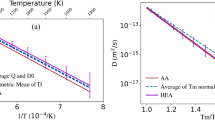Abstract:
In this work the diffusion of non-interacting adsorbates on a random AB alloy surface is considered. For this purpose a simple cubic (sc), body-centered cubic (bcc) or face-centered cubic (fcc) auxiliary metal lattice is introduced. The auxiliary lattice is truncated parallel to its (100) plane in such a way that the fourfold hollow positions of the metal surface form a regular net of adsorption sites with square symmetry. The adsorption energy of each adsorption site is determined by its own environment, i.e. by the numbers of direct A or B neighbors. The Monte-Carlo method has been utilized to simulate surface diffusion of adsorbates on such energetically heterogeneous alloy surfaces and to calculate the tracer, jump and chemical diffusion coefficients. The chemical diffusion coefficient was calculated via two different approaches: the fluctuation and the Kubo-Green method. The influence of energetical heterogeneities on the surface diffusion is largely pronounced at low temperatures and low surface coverages, where most of the adatoms are trapped by deep adsorption sites. It was found that at low temperatures the sequential occupation of the different types of adsorption sites can be observed.
Similar content being viewed by others
Author information
Authors and Affiliations
Additional information
Received: 24 October 1997 / Accepted: 17 December 1997
Rights and permissions
About this article
Cite this article
Nieto, F., Uebing, C. Diffusion of adsorbates on random alloy surfaces. Eur. Phys. J. B 1, 523–531 (1998). https://doi.org/10.1007/s100510050215
Received:
Issue Date:
DOI: https://doi.org/10.1007/s100510050215




